
Letter From The Executive Director
Dr. Robert M. Panoff
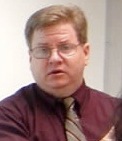
We are about to start the first summer in our new home. With this being the fourth space that Shodor has occupied since its founding in May of 1994 I am reminded that this year is actually the 20th anniversary of the project that eventually became Shodor: the 1992 Carolinas Summer Institute in Computational Science (CSICS). Back then, when the nation's faster supercomputers were barely a few percent of what a laptop is today, we brought teams of college faculty together at the North Carolina Supercomputing Center, then part of MCNC, and taught them vector programming in FORTRAN to run on a supercomputer, since that was the only way to build a model that would run fast enough to be used in a classroom setting. Those faculty worked in a 3-week institute in teams of 3 professors, with one each from science, math, and computer science. What we learned that summer set the stage for what we now do with middle and high school students, college students and teachers and faculty at all levels, using modeling software to explore science and math in dynamic ways on computers 100, 1000, and even 1,000,000 times faster!
Besides the important work to create the best web-accessible learning tools and lessons-work that is being done by our interns under the direction of our staff- we'll be reaching hundreds of rising middle and high school students through our explorations in science, technology, engineering, and mathematics, what has come to be known as "STEM". We'll do this with hands-on and minds-on activities centered around topics such as Modeling Your World, Forensic Science, and Math Explorations. We encourage you to help us spread the word to the children of your friends and the friends of your children, so that more kids will encounter the excitement of discovery, the power of inquiry, and the joy of learning.
I thank all of you and each of you for your continued encouragement and support,
All the best,

Bob Panoff
APPLES Intern Enjoys Shodor Experience
BY Kristen Ross, Shodor Intern
As a senior at UNC Chapel Hill, I wanted to make my last year count. Fortunately I was able to make that happen as an APPLES intern at Shodor. APPLES, which stands for Assisting People in Planning Learning Experiences in Service, is a student-run, staff-supported organization at UNC-Chapel Hill that provides students an opportunity to participate in their community. APPLES initiatives are service-learning projects that range from alternative spring breaks, courses, and, in my case, internships.
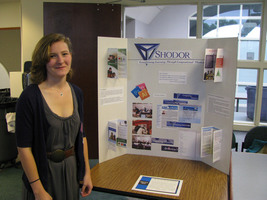
My APPLES internship required me to complete 150 hours of work at Shodor as well as a weekly three-hour course conducted through the UNC School of Social Work. Not only was I able to bring the skills and values that I learned to Shodor, but I have learned so much more. My main project for the semester was to develop Shodor's blog. This meant not just writing content, but also developing my graphic design skills. I have also been able to learn CSS and HTML. I have enjoyed interacting with Shodor's community partners and helping Shodor staff at career fairs and in student workshops. My experience at Shodor has been amazing and has allowed me to explore skills that I had not previously considered. Receiving this internship has given me a greater appreciation for the work that Shodor does and the role they play in our community.
Exploration In Engineering at Chewning Middle School
BY Austin Galny, Shodor Intern
Shodor's Explorations In Engineering (EIE) visited Innovations For Motivation (i4M) held at Chewning Middle School in Durham from Tuesday March 27th through Friday March 30th. Explorations In Engineering teaches introductory engineering and computational computing fundamentals. During this week, eight students had the opportunity to learn and experience several facets of structural engineering.
During the workshop, students were introduced to the engineering concept of center of mass. At the beginning of the workshop, students were asked to figure out how to balance a 6x1 Lego block on a 2x1 Lego block and record what combinations they came up with. After their initial discoveries, students were instructed to come up with 5 different designs using various sizes of Legos, sketch their designs, and tell us if their Lego structures stood or toppled. The students noticed that symmetrical structures tended to balance easier than asymmetrical structures; a computer based cross-sectional applet was also used as a learning tool and allowed the students to easily visualize why their structures fell or stood.
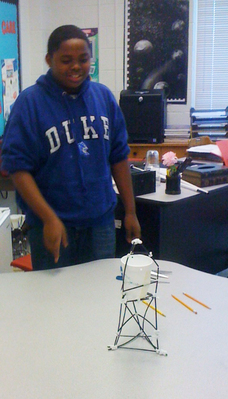
Workshop participants also learned about the strength of trusses and what shapes are ideal for use in construction, which proved to be useful information when they participated in a competitive team project to create the tallest and strongest structure. Scoring was calculated by multiplying the height of the structure by the number of marbles the cup could hold without causing damage to the structure. The students formed four teams and began working with construction materials (coffee stirrers and pipe cleaners) to build their structures. By the end of the day there were some impressive structures being built.
Friday, the last day of the workshop, the student teams finished up their structures; each one was uniquely designed. The rule of the competition was that one of the instructors would add marbles into the cup until the engineering team told the instructor to stop. If the structure remained standing after the marbles were added, students would be scored on the number of marbles held and height of the structure. The first team set an impressive score with their height of 11cm as they steadily pushed the marble count to 34. Team 2 wasn't shaken as they volunteered next. Their determination paid off, setting a new marble count to 45 and their height of 15cm. Team 3 set the overall height record of 19cm, but, as marbles were added, their structure started showing problems, and around the 15th marble, it sadly fell over, disqualifying the team's entry. Team 4, scared about what just happened, timidly brought their structure. It held up well until the 20th marble was added and started showing signs of toppling, at which point no more marbles were added. After all of the teams had finished their presentations the team's scores were tallied and team 2, the winner, was awarded a 4 GB flash drive for each student.
The Explorations In Engineering workshop held at Chewning Middle School's i4M was a huge success and was exciting for not only the students but also the staff teaching the material. The students left happy with their structures and were elated about the fun they had during the week.
Shodor Partners with NVIDIA
BY Kristen Ross, Shodor Intern
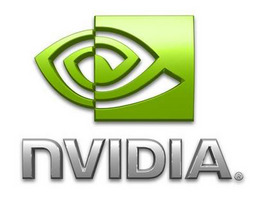
Shodor recently partnered with NVIDIA, a technology company known for its high performance graphics processors. In February, Shodor received one of NVIDIA's top-of-the-line graphics processors and a $500 grant to build a computer system to support the new graphics processor. The new machine has an Intel quad core i5 processor and Tesla C2075 graphics processor, which has 448 cores (14 multiprocessors, each with 32 cores) and 6 GB of RAM. This card uses NVIDIA's CUDA architecture and high-level parallel programing model and instruction set.
Shodor has been developing CUDA-based teaching modules as a part of the Blue Waters Undergraduate Petascale Education Program, a project launched to help prepare students with computational skills to advance scientific computing through the use of high performance computing. The addition of thisnew machine gives Shodor the in-house ability to write and test these CUDA-based learning modules, speeding up the time it will take to develop and test these modules.
This machine will also be used in various workshops that promote high performance computing. Specifically, the Modeling Your Universe workshop this summer will be using the NVIDIA processor to explore large-scale modeling by looking at models that require a large amount of parallel computation, utilizing the processor's ability to handle many concurrent operations. This will allow students to be able to see models that are larger and more complex than a single computer would be able to run.
Where Are They Now? Gavin Borg
BY Jacqueline McAuley, Shodor Intern
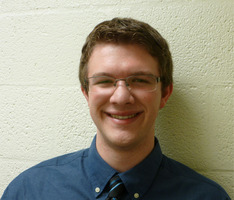
Gavin Borg began as an apprentice at Shodor in 2006 and in 2008 began working as an intern. Gavin has been with Shodor for quite some time and has had an exceptional experience with the program. He says that it "promotes a wonderful atmosphere for learning--the staff, interns, and even apprentices are always happy to help you in any way they can."
Gavin is currently a junior at Wake Forest University majoring in Computer Science and minoring in Math. While he does not yet have a full time job, he has accepted a position as a software development intern with Epic Systems for this summer. By 7th grade, Gavin had developed an interest in computer science but wasn't aware of exactly how to pursue this. It was Shodor that allowed him to really learn about the field; it was where he first learned how to program. His interest in programming started on a basic, loose level but later turned into more object-oriented programming. He says that Shodor basically "jump-started [him] onto [his] career path" because of how important programming is to the things that he does with his courses, campus websites, and his internship.
With his success, Gavin leaves two big pieces of advice for future as well as current interns and apprentices: "Do your work to the best of your ability - not only will those around you notice and appreciate it, but if someone after you has to modify or use what you've created, they will very much appreciate a job well done" and "don't be afraid to ask for help if you're stuck - use the resources you have to figure out how to solve a particular problem, but if you are completely stuck, don't hesitate to ask around for someone who can point you in the right direction."
Congratulations! Thank you for all your hard work!
The following Shodor interns and staff are graduating this Spring...
- Cameron Aviles, Shodor intern; graduating from C.E. Jordan High School and is attending Durham Technical Community College in the Fall.
- Tyler Chamberlain, Shodor intern; graduating from Apex High School and is attending Wake Technical Community College in the Fall.
- Brittany Coleman, Shodor intern; graduating from J. D. Clement Early College High School and is attending East Carolina University in the Fall.
- Andre Labinowicz, Shodor intern; graduating from Elon University with a Bachelors of Arts in Pure Mathematics and is moving to Canada after graduation to pursue a career in professional football.
- Rachel Leeman-Munk, Shodor intern; graduating from Earlham College with a Bachelor of Arts in Mathematics and is planning on interning for a year with the Episcopal Service Corps.
- Kristen Ross, Shodor intern; graduating from University of North Carolina Chapel Hill with a Bachelors of Arts in Journalism and Communications and is looking for permanent employment and traveling when possible.
- Shobhank Sharma, Shodor intern; graduating from North Carolina State University with a Masters degree in Computer Science and will begin working at Akamai Technologies in June.
- Alexandra Solender, Shodor intern; graduating from Elon University with a Bachelors of Arts in Physics and Secondary Science Education and plans on teaching high school locally.
- Hillary Stoker, Shodor staff; graduating from North Carolina State University with a Masters degree in International Education and is looking for permanent employment in that field.
- Ada Taylor, Shodor intern; graduating from North Carolina School of Science and Math and is attending MIT in the Fall.
NCSSM Visits Shodor
BY Hillary Stoker, Shodor Staff
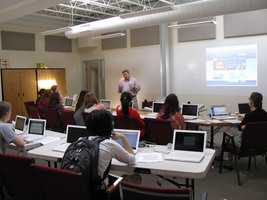
As part of a new course being offered at North Carolina School of Science and Math (NCSSM), teacher Tamar Avineri accompanied a group of students on a field trip to Shodor on March 1st, 2012. "I chose Shodor for a field trip for a few reasons. I have worked with Shodor in the past, and also Shodor is the only non-profit we visited that served the cause that Shodor serves, so our visit provided some critical information for my students and me about what different non-profits can look like," says Avineri. During their visit the NCSSM students were presented with Shodor history as well as a brief introduction into computational science and computational thinking. "My students and I had a wonderful time at Shodor! We all learned so, so much," said Avineri.
Fayetteville Shodor Workshop
BY Alexandra Solender, Shodor Intern
Jenny Jones taught a Shodor workshop on April 12, 2012 for homeschooled students and parents in Fayetteville, NC. A native of Fayetteville, Jenny was also homeschooled when she was younger, making the experience that much more rewarding. She worked with the students and their parents to give them an introduction to computational thinking and science. The workshop included many activities and topics that are typically seen in Shodor summer workshops that motivate students to ask questions, search for logical explanations, and learn to not blindly trust information on the internet. Students got to use a hands-on approach by completing varied activities such as investigating a box of straws and using Google to determine the mass of Pluto. With the box of straws, students examined the box and concluded that there were 40 straws in it because that was the number given on the package. After opening the box and discovering that there were not exactly 40 straws inside, students began to question what other information may be wrong or misinformed. They continued this type of investigation throughout the workshop in a computational manner.